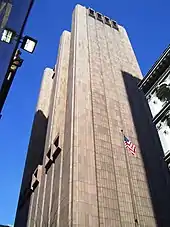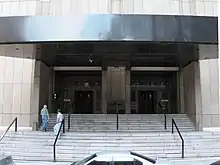33 Thomas Street
33 Thomas Street (formerly the AT&T Long Lines Building) is a 550-foot-tall (170 m) windowless skyscraper in the Tribeca neighborhood of Lower Manhattan in New York City, New York, United States. It stands on the east side of Church Street, between Thomas Street and Worth Street. Designed in the Brutalist architectural style, it is a telephone exchange or wire center building which contained three major 4ESS switches used for interexchange (long distance) telephony, as well as a number of other switches used for competitive local exchange carrier services. However, it is not used for incumbent local exchange carrier services, and is not a central office.
| 33 Thomas Street | |
|---|---|
AT&T Long Lines Building | |
 | |
| General information | |
| Status | Completed |
| Type | Utility |
| Architectural style | Brutalist |
| Location | Manhattan, New York City, New York, U.S. |
| Coordinates | 40.71678°N 74.00610°W |
| Construction started | 1969 |
| Completed | 1974 |
| Opening | 1974 |
| Owner | AT&T |
| Height | |
| Roof | 550 ft (170 m) |
| Technical details | |
| Floor count | 29 |
| Design and construction | |
| Architect(s) | John Carl Warnecke |
| Developer | AT&T |
The CLLI code for this facility is NYCMNYBW. The building has also been described as the likely location of a National Security Agency (NSA) mass surveillance hub codenamed TITANPOINTE.[1]
History
The location was previously the site of cast-iron buildings, typical of the area, the facades of which were preserved before demolition.[2] The building was a core part of the AT&T Long Lines Department, housing solid-state switching equipment that required tight security and ample space. The Long Lines Department became AT&T Communications in 1984 after the Bell System divestiture. The AT&T Long Lines Building is now commonly known by its street address, 33 Thomas Street.[3]
AT&T gradually moved switches and other facilities from their former AT&T Long Lines headquarters building at 32 Sixth Avenue, just a few blocks away, completing the move by 1999.[4] 33 Thomas is still used for telephone switching, but some of the space is also used for highly secure datacenters.
On September 17, 1991, management failure, power equipment failure, and human error combined to disable AT&T's central office switch at 33 Thomas. More than 5 million calls were blocked, and Federal Aviation Administration private lines were also interrupted, disrupting air traffic control to 398 airports serving most of the northeastern United States. The problem arose when the electric utility, Consolidated Edison, asked AT&T to temporarily stop drawing electricity from the grid and instead use the building's on-site generators. The request was part of a previous load shedding agreement, and the switch had been performed successfully in the past, but on this occasion, it went wrong. After switching power sources, standard procedure was to check all the equipment power supplies, known as DC plants, for problems. But due to scheduled training, the check was not performed, and one plant went on battery backup. The alarms were not detected until it was too late to maintain uninterrupted power.[5]
After the destruction of the World Trade Center in the September 11, 2001 attacks, AT&T Local Services restored lost facilities they acquired from the former Teleport Communications Group based there, to 33 Thomas and 811 Tenth Avenue.[6]
Architecture

The Long Lines Building was designed by architect John Carl Warnecke in the Brutalist style and completed in 1974.[7] Its style has been generally praised, with The New York Times saying it is a rare building of its type in Manhattan that "makes sense architecturally" and that it "blends into its surroundings more gracefully" than any other skyscraper nearby.[8]
Facade
The exterior walls have no windows (other than the entrance) and are made from precast concrete panels clad with flame-treated textured Swedish granite faces. There are six large protrusions from the rectangular base which house air ducts, stairs and elevators. There is a series of large, protruding ventilation openings on the 10th and 29th floors.[9] William H. Whyte claimed that it features the tallest blank wall in the world.[10][11]
Features
As it was built to house telephone switching equipment, the average floor height is 18 feet (5.5 m), considerably taller than in an average high-rise. The floors are also unusually strong, designed to carry 200-to-300-pound-force-per-square-foot (9.6 to 14.4 kPa) live loads.[7] It is often described as one of the most secure buildings in America, and was designed to be self-sufficient with its own gas and water supplies along with generation capabilities and protected from nuclear fallout for up to two weeks after a nuclear blast.[2]

The building is a telephone exchange or wire center building which contained three major 4ESS switches[12] used for interexchange (long distance) telephony, two owned by AT&T[13][14] and one formerly owned by Verizon (decommissioned in 2009).[15] It also contains a number of other switches used for competitive local exchange carrier services,[16] but is not used for incumbent local exchange carrier services, and is not a central office.[12] The CLLI code for this facility is NYCMNYBW.[17]
33 Thomas is likely a location of a mass surveillance hub operated by the National Security Agency, codenamed TITANPOINTE.[1] An investigation by The Intercept, and in a documentary short film by Henrik Moltke and Laura Poitras titled Project X, both identified TITANPOINTE by drawing on the surveillance disclosures of Edward Snowden. The investigation ties the facility to a nearby Federal Bureau of Investigation building, and its rooftop equipment to NSA's SKIDROWE satellite intelligence system.[18][1]
In popular culture
- In the 1979 conspiracy satire film Winter Kills, 33 Thomas is depicted as the headquarters of a global surveillance operation run by John Cerruti, played by Anthony Perkins.
- Teju Cole refers to Long Lines in his first novel, Open City, about New York.
- Long Lines appears in season 3 of the TV show Mr. Robot as a bank records storage facility of E Corp.
- The building prominently appears in The X-Files episode "This".
- It is the building where Clive Owen, playing detective Sal Frieland, works in the 2018 Netflix movie Anon.
- The building has been cited as inspiration for the Oldest House, the setting of the video game Control by Remedy Entertainment.[19]
See also
References
- Gallagher, Ryan; Moltke, Henrik (November 16, 2016). "Titanpointe: The NSA's Spy Hub in New York, Hidden in Plain Sight". The Intercept. Retrieved November 17, 2019.
- "New York Scrapers – International Style III". Great Gridlock.net. Archived from the original on June 30, 2007. Retrieved July 24, 2007.
- "MTA Neighborhood Maps: Lower Manhattan" (PDF). Metropolitan Transportation Authority. 2015. Retrieved October 1, 2018.
- Weiss, Lois. "Rudins". AllBusiness.com. Archived from the original on February 10, 2012. Retrieved July 25, 2007.
- United States House Committee on Energy and Commerce (1992). Review of Telephone Network Reliability and Service Quality Standards. pp. iv to v.
- "WTC Tenant Relocation Summary". TenantWise. Archived from the original on March 20, 2006. Retrieved July 25, 2007.
- "AT&T Long Lines Building". Emporis. Archived from the original on August 15, 2004. Retrieved July 24, 2007.
- Goldberger, Paul (October 8, 1982). "The TriBeCa Scene: Architecture, Restaurants and Bargain Hunting; The TriBeCa Scene: The Flavor Is Found in the Architecture". The New York Times. p. C1.
- "AT&T Long Lines Building". New York Architecture Images. Archived from the original on August 7, 2007. Retrieved July 24, 2007.
- Roberts, Sam (February 20, 1989). "Urban Dance: Choreographing The City Streets; New York pedestrians, an expert says, 'walk fast and they walk adroitly'". The New York Times. p. B1.
- White, Norval & Willensky, Elliot (2000). AIA Guide to New York City (4th ed.). New York: Three Rivers Press. ISBN 978-0-8129-3107-5., p. 76
- Morris, John (July 21, 2009). "The Most Reclusive Building Downtown". Goodnight Raleigh. Archived from the original on June 9, 2017. Retrieved April 2, 2013.
It's a long distance exchange ... and not a CO, and houses three of the largest telephony switches ever created – 4ESS.....
- "33 Thomas Street, owned by AT&T". Cylex Business Directory. Retrieved April 2, 2013.
- "33 Thomas St, New York, NY 10007, owned by AT&T". Yahoo listing. Retrieved April 2, 2013.
- "Retirement and Removal of Verizon Broadway 4ESS Tandem (NYCMNYBW21T)]" (PDF). Verizon. December 8, 2009. Archived from the original (PDF) on January 1, 2014. Retrieved April 2, 2013.
CLEC, IXC, IEC, wireless and paging carriers ...
- "PUBLIC NOTICE OF NETWORK CHANGE UNDER RULE 51.329(A)" (PDF). Verizon. November 9, 2009. Archived from the original (PDF) on January 1, 2014. Retrieved April 2, 2013.
33 Thomas St (tandem) NYCMNYBW21T ... CLEC IXC, IEC, wireless and paging carriers will need to secure new trunk groups
- "Search for Switches by (partial) CLLI Code". Telcodata.US. Retrieved July 25, 2007.
- Dwyer, Jim (November 17, 2016). "National Security Agency Said to Use Manhattan Tower as Listening Post". The New York Times.
- Wilson, Ewan (September 3, 2019). "Remedy's Control is built on concrete foundations". Eurogamer. Retrieved September 4, 2019.